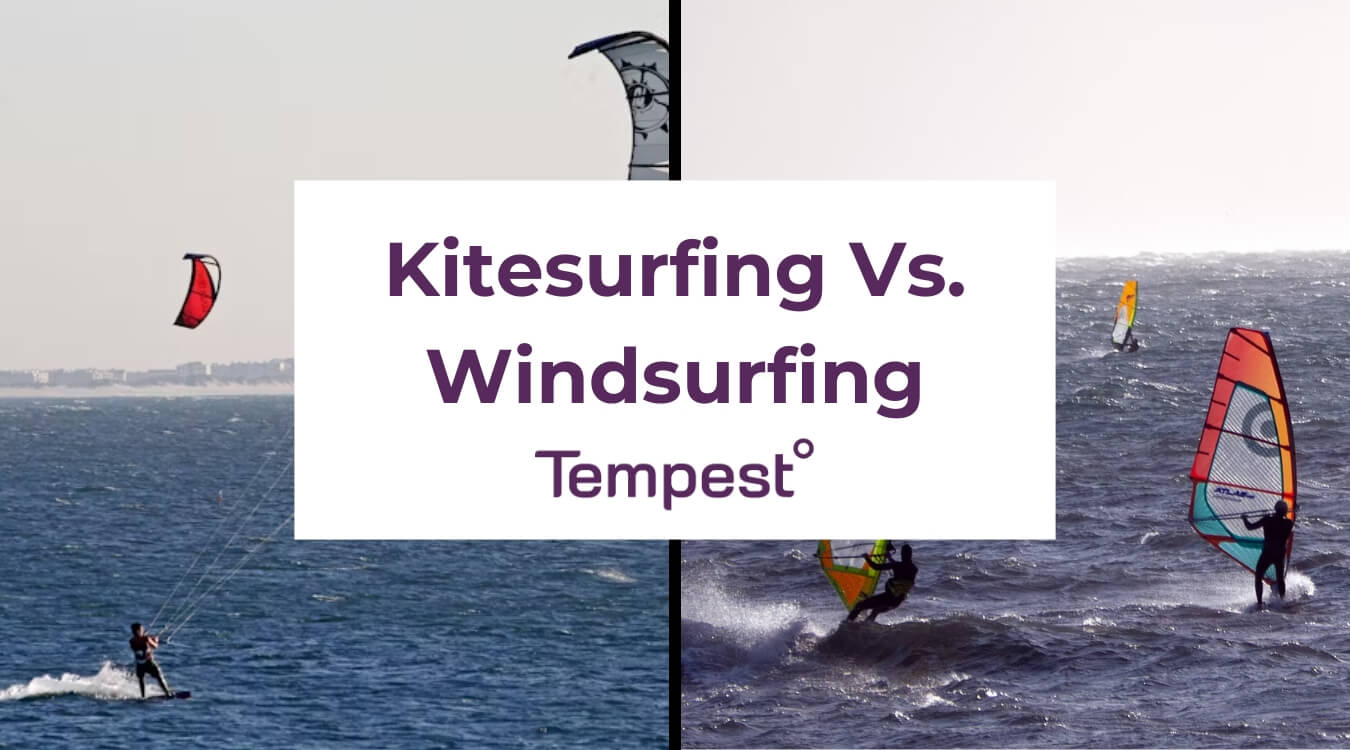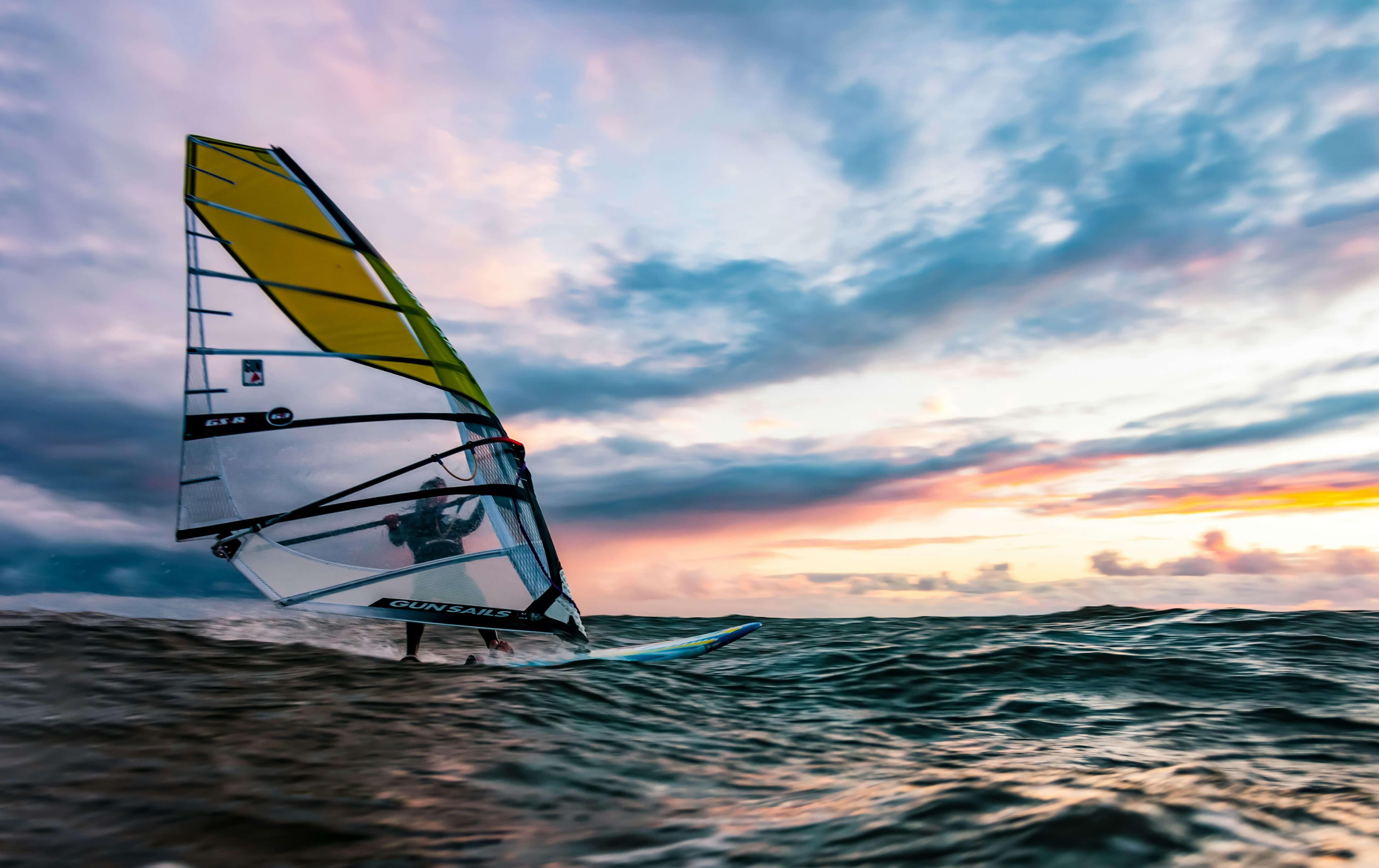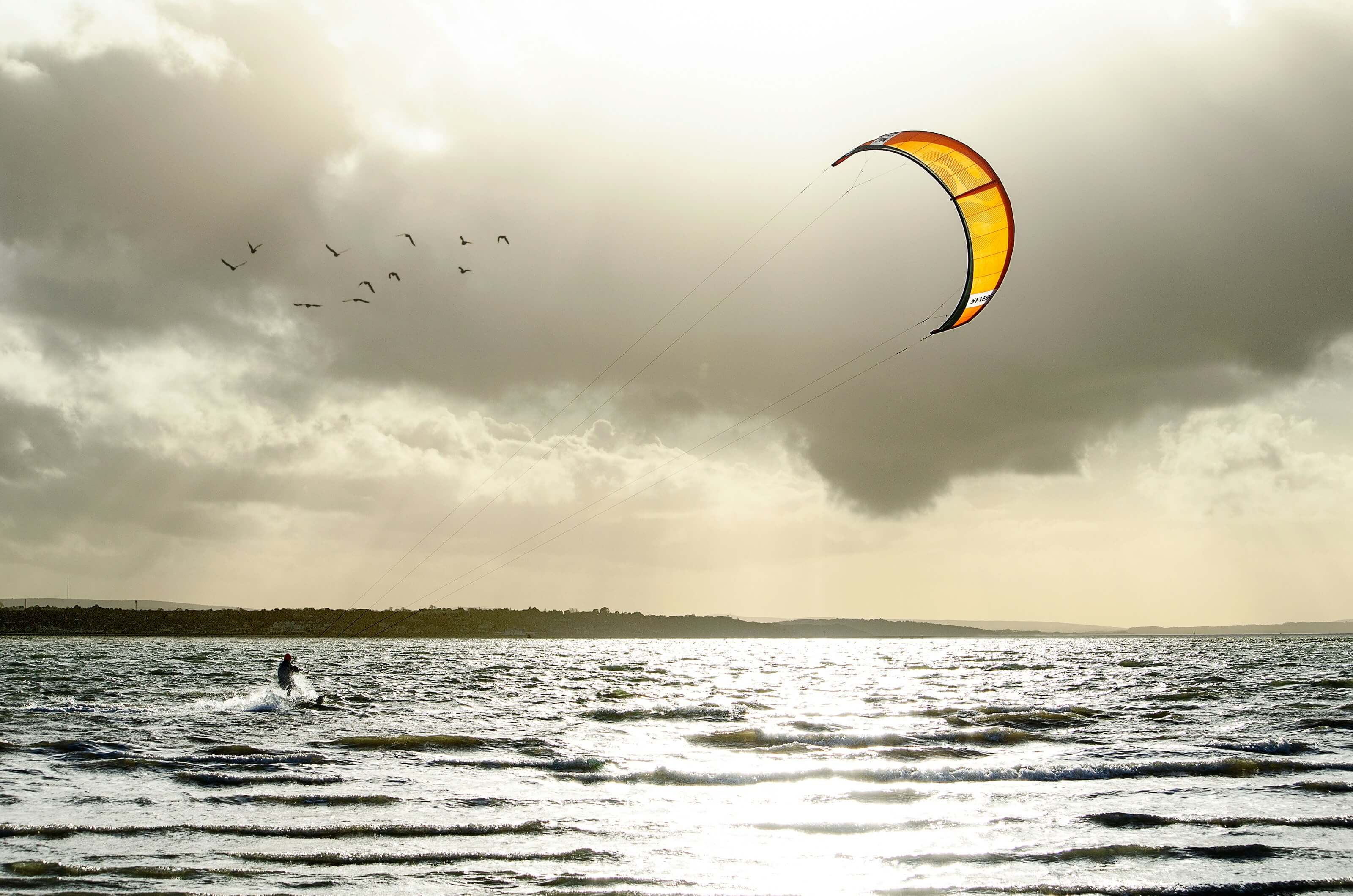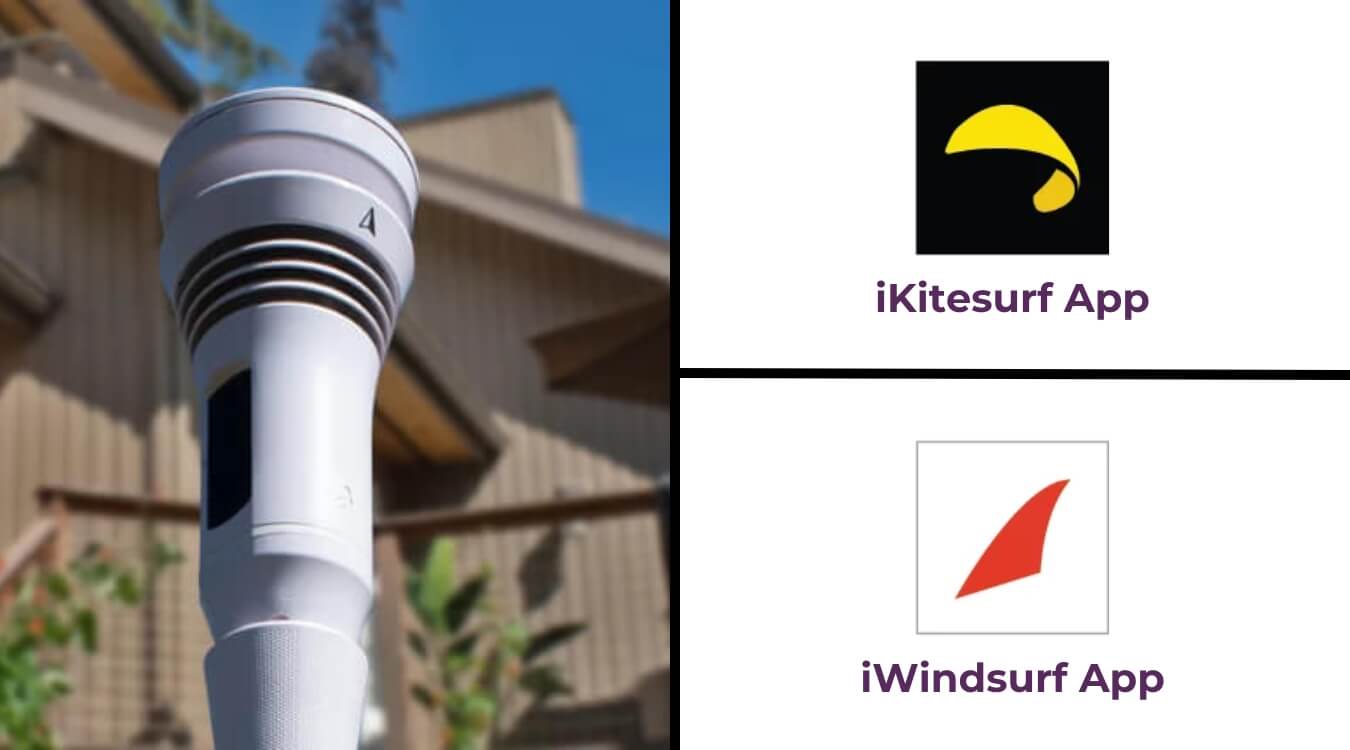
If you’re interested in extreme sports, you might wonder – what’s the difference between windsurfing vs. kiteboarding? Though both require wind and water, the equipment needs, ideal weather, learning curve, and safety considerations for each can vary.
Windsurfing and kitesurfing are two popular water sports, though there’s a long-standing debate over which one is better. As a newcomer, these wind sports might appear quite similar. However, there are some key distinctions between them that all beginners should be aware of. Below, we’ll discuss the difference between windsurfing and kitesurfing to help you select the outdoor hobby that’s right for you.
Download the iKitesurf app for real-time wind observations and forecasts at over 100,000 key locations around the globe.
What Is Windsurfing?
Windsurfing is a cross between surfing and sailing, as the name might suggest. The sport has been around for decades and became one of the Olympic sailing events in 1984.
You can think of it as surfing with a sail, as riders use a board with a sail attached to it for propulsion. Riders must balance on the board and control the sail with their arms and body weight, using wind power to navigate and perform maneuvers on the water.
What Is Kitesurfing?
Kitesurfing, or kiteboarding, is an extreme sport that’s a combination of surfing and paragliding. Athletes wear a harness that’s attached to a large kite, while the board is attached to their feet via foot straps. The kite acts as a sort of parachute, harnessing wind power to help riders glide over the water and even lift them several feet above the surface.
Kitesurfers must have the strength and technical skills to steer the kite for optimal speed, navigate waves, coordinate lifts to do jumps and tricks, and depower the kite to get out of trouble.
Shop the Tempest WEATHERmeter to measure wind, temperature, humidity, and pressure on the go.
Kitesurfing Vs. Windsurfing: 8 Key Differences
Kitesurfing and windsurfing both occur on the water and rely on wind power for propulsion. However, that’s about where the similarities end. There are staunch differences between these sports that might make one more appealing to you based on your experience, location, and personal preferences. Here’s a closer side-by-side comparison of kite vs. windsurfing.
Equipment
One of the main differences between the two sports is the equipment and gear they require. The main pieces of equipment for windsurfing are the board and sail. The board is typically larger, like a standard surfboard or stand-up paddleboard. Kitesurfers’ most important piece of equipment is the kite and harness. They also use a version of a board, though it’s much smaller, like a wakeboard.
The cost of the equipment is pretty comparable for both sports, which can be upwards of $1,000 for new or a few hundred dollars for used. In general, windsurfing equipment tends to last longer, while kitesurfing gear may need to be replaced more frequently.
Ease Of Transportation
It’s often easier to transport kitesurfing equipment, as windsurfing gear tends to be bulkier and heavier. This includes the large board, sails, and other gear weighing up to 60 or 70 pounds in total. Kitesurfing gear can be more compact and portable, which may be an advantage for frequent travelers or those with smaller vehicles.
Location
Windsurfing generally requires larger, deeper bodies of water. Depending on where you live, your location may not be conducive to the sport. Kitesurfing may be more adaptable to varied locations, including beaches with consistent wind and space for launching and landing. However, you’ll need to find an area with open surroundings, as trees, lamp posts, and other tall structures could be a risk for kite lines, though this isn’t as much of a concern for windsurfing.
Wind And Weather Conditions Needed
Of course, both windsurfing and kitesurfing rely on wind power to some degree. But, kitesurfing typically requires strong and steady wind, while windsurfing is compatible with breezy conditions. Plus, large gusts can be more challenging for kitesurfing newcomers as they learn how to handle the kite and keep the lines straight. In comparison, windsurfing in gusty conditions is generally still safe and enjoyable, even for beginners.
With either sport, it’s important to check accurate weather forecasts and surf reports for your area before heading out. This will help you stay safe and ensure optimal conditions for your activity of choice. Apps like iWindsurf deliver precise weather data for windsurfers, including live wind reports and forecasts from over 100,000 weather stations worldwide.
Learn what causes wind and how patterns can shift throughout the day to plan your outdoor activities accordingly.
Learning Difficulty
When comparing kiteboarding vs. windsurfing in terms of learning difficulty, both sports present unique challenges for beginners regarding control, stability, and technique. Some riders say windsurfing is easier to start initially, though it can be more challenging to master controlling the sails and balancing on the board.
Kitesurfing may have a steeper learning curve at first as riders learn how to handle the kite. However, they may reach mastery quicker with kitesurfing.
Fitness Difficulty
Both sports are physically demanding but in different ways. For instance, windsurfing tends to require more upper body strength, as riders must maintain control of the sail using their arms. On the other hand, kitesurfing may demand more core strength and technical skills to handle the kite.
Overall, kitesurfing may require less stamina and physical strength than windsurfing. However, each sport provides a great full-body workout and requires a certain level of fitness.
Surfing Speed
Both kitesurfers and windsurfers can achieve high speeds, depending on the wind and water conditions and the skill level of the rider. Windsurfers typically run faster on average, while kitesurfers can accelerate more quickly, though both have similar top speeds in the right circumstances. Where kitesurfers may not go as fast on average, the freedom and thrill of lifting off the water generally make up for it.
Safety Levels
From a safety standpoint, windsurfing is generally seen as the safer of the two. Kitesurfing is a more adventurous, albeit more extreme, sport, sometimes lifting riders dozens of feet into the air. This opens the door for more accidents, line entanglements, and other potential risks.
Windsurfing offers its own dangers, like controlling the sail in high winds. Thus, riders who attempt either sport should have the proper training, gear, and weather awareness to keep themselves and others safe.
Download iKitesurf Or iWindsurf For Accurate Wind Readings
Kitesurfing and windsurfing are both fun activities that allow you to enjoy the water and challenge yourself on a technical and physical level. If you’re looking for something that’s a bit safer and more of a workout, you might want to check out windsurfing. But, if you are seeking a thrill and don’t want the hassle of transporting large, bulky equipment, consider kitesurfing.
Download the iKitesurf or iWindsurf apps to access the real-time weather data you need to plan a safe and enjoyable day on the water.
If you’re looking for more accurate local weather data, the Tempest Weather System is a personal weather station that can help you feel more confident about planning your outdoor activities.


